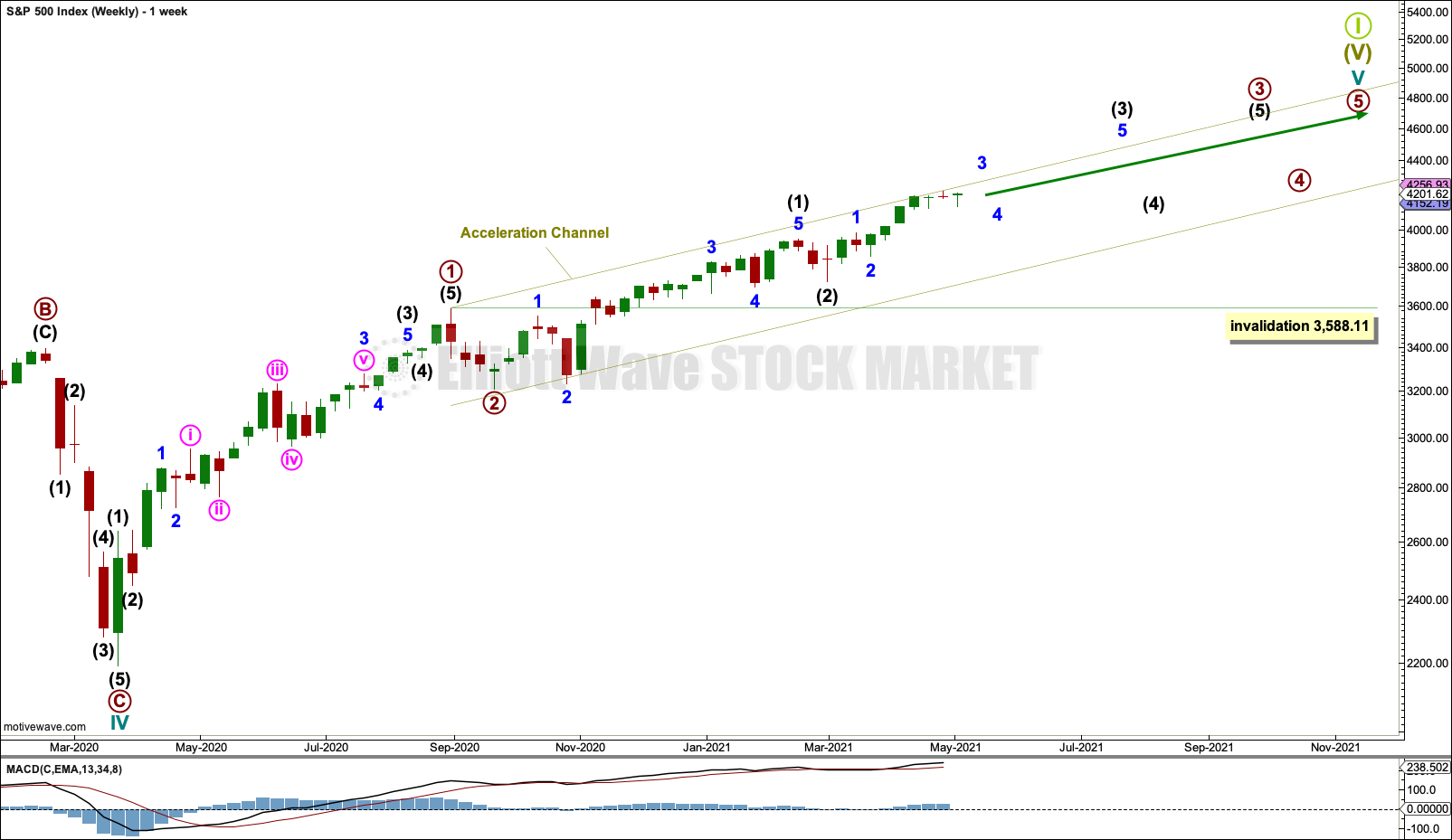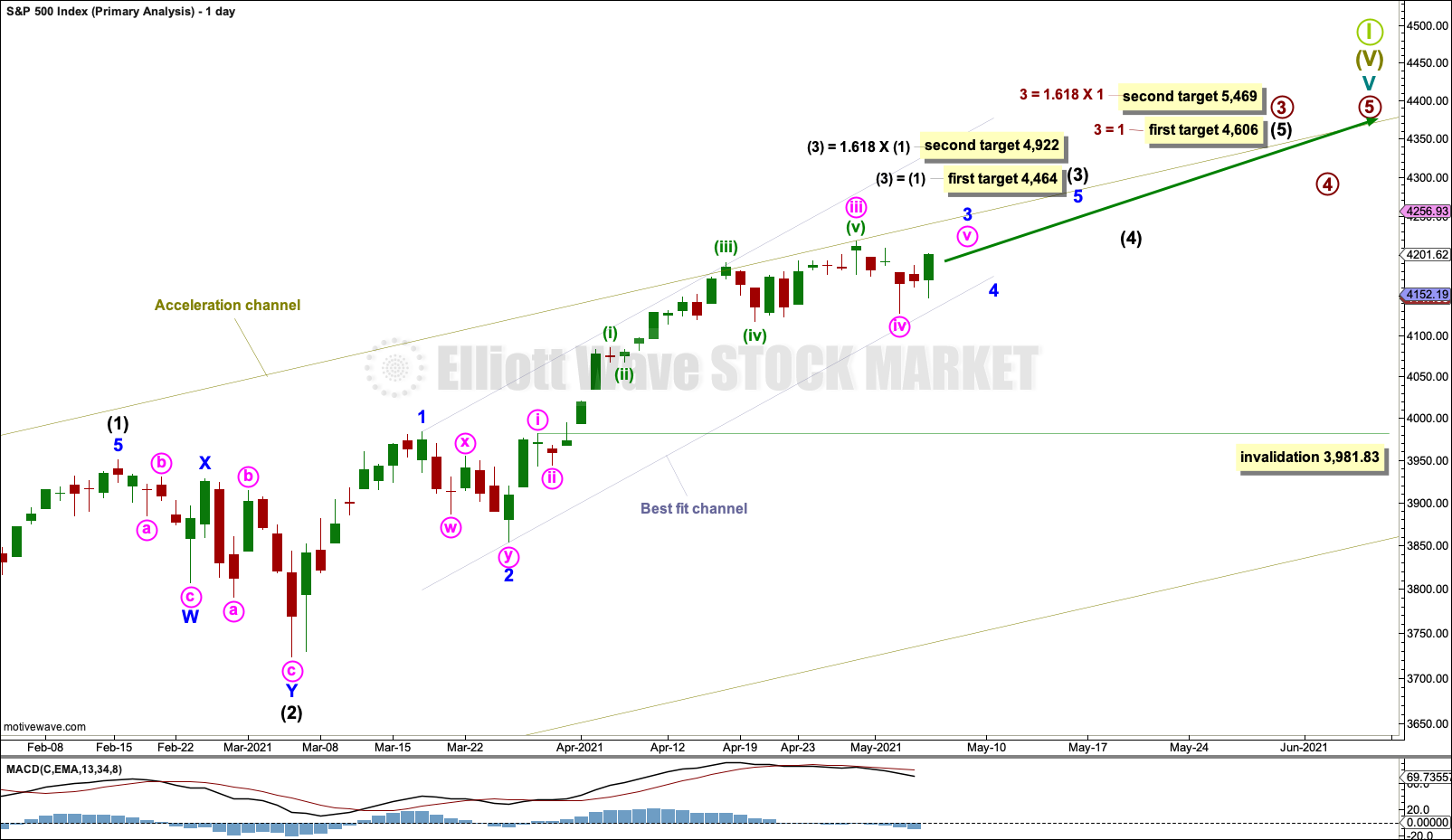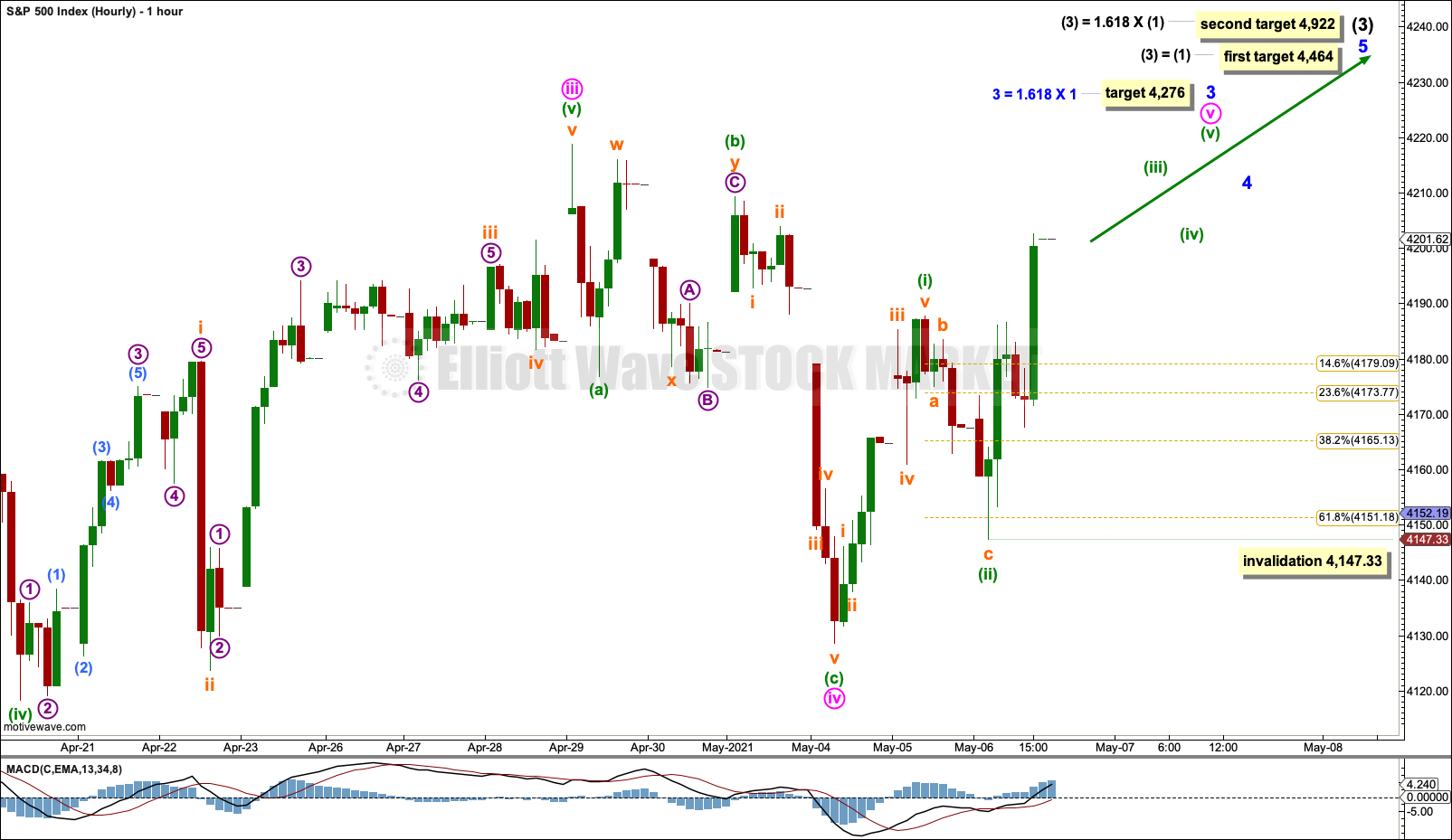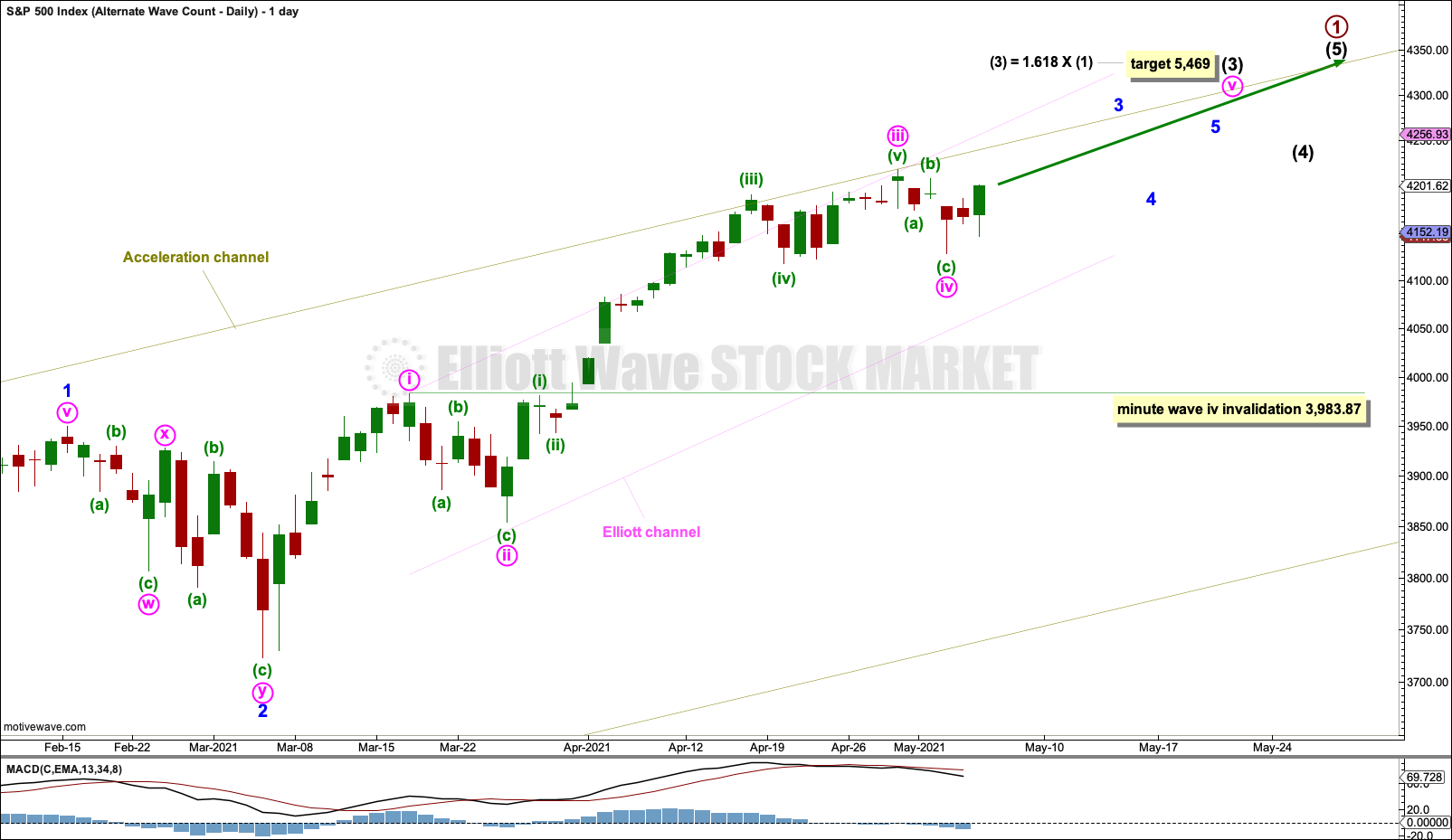S&P 500: Elliott Wave and Technical Analysis | Charts – May 6, 2021
Both Elliott wave counts yesterday expected that a correction was over and an upwards trend should resume. An upwards session closing with strength fits the expectation.
Summary: The main and alternate Elliott wave counts may have about an even probability. Both expect a small correction is over and upwards movement may resume.
The main Elliott wave count has a short-term target at 4,276 and then the next mid-term targets at either 4,464 or 4,922. About one of these targets a multi-week pullback may begin.
The alternate Elliott wave count is labelled one degree lower and has the next target at 5,469.
The biggest picture, Grand Super Cycle analysis, is here.
Monthly charts are last updated here with video here.
MAIN WAVE COUNT
WEEKLY CHART
Cycle wave V may last from one to several years. So far it is in its fourteenth month.
This wave count may allow time for the AD line to diverge from price as price makes final highs before the end of the bull market. The AD line most commonly diverges a minimum of 4 months prior to the end of a bull market. A longer divergence is positively correlated with a deeper bear market. A shorter divergence is positively correlated with a more shallow bear market. With zero divergence at this stage, if a surprise bear market does develop here, then it would likely be shallow.
A longer divergence between price and the AD line would be expected towards the end of Grand Super Cycle wave I.
It is possible that cycle wave V may continue until 2029, if the 2020s mirror the 1920s (although the alternate weekly wave count fits this expectation better).
Cycle wave V would most likely subdivide as an impulse. But if overlapping develops, then an ending diagonal should be considered. This chart considers the more common impulse.
Primary waves 1 and 2 may be complete.
Primary wave 3 may only subdivide as an impulse.
Primary wave 3 has now moved well above the end of primary wave 1. Primary wave 4 may not move into primary wave 1 price territory below 3,588.11.
There is already a Fibonacci ratio between cycle waves I and III within Super Cycle wave (V). The S&P500 often exhibits a Fibonacci ratio between two of its actionary waves but rarely between all three; it is less likely that cycle wave V would exhibit a Fibonacci ratio. The target for Super Cycle wave (V) to end would best be calculated at primary degree, but that cannot be done until all of primary waves 1, 2, 3 and 4 are complete.
An acceleration channel is drawn about cycle wave V. Draw the first trend line from the end of primary wave 1 to the last high, then place a parallel copy on the end of primary wave 2. Keep redrawing the channel as price continues higher. When primary wave 3 is complete, then this channel would be drawn using Elliott’s first technique and may show were primary wave 4 may find support.
DAILY CHART
Within primary wave 3: Intermediate wave (1) may be complete, intermediate wave (2) may also be complete as a double zigzag, and intermediate wave (3) may now be underway and may have passed its middle.
Minor wave 3 within intermediate wave (3) may be nearing an end. Minute wave iv within minor wave 3 may not move into minute wave i price territory below 3,981.83.
Targets are calculated for intermediate wave (3) and primary wave 3. The first target for intermediate wave (3) would work with the first target for primary wave 3, and the second target for intermediate wave (3) would work with the second target for primary wave 3.
As price approaches the next target at 4,464, if the structure may be complete, then intermediate wave (3) may end there. But if price keeps rising through the first target or the structure is incomplete, then the next target would be used.
HOURLY CHART
Within minor wave 3: Minute waves i, ii, iii and iv may now all be complete, and minute wave v may have begun.
Minuette waves (i) and (ii) within minute wave v may be complete. Subminuette wave ii within minuette wave (iii) may not move beyond the start of subminuette wave i below 4,147.33.
ALTERNATE WAVE COUNT
WEEKLY CHART
The degree of labelling within cycle wave V is moved down one degree from the main wave count; primary wave 1 may be incomplete. This gives a much more bullish wave count, expecting a much longer duration for cycle wave V which has not yet passed its middle strongest portion.
Within primary wave 1: Intermediate waves (1) and (2) may be complete, and intermediate wave (3) may now be nearing an end.
Within intermediate wave (3): Minor waves 1, 2, 3 and 4 may all be complete, and minor wave 5 may be nearing an end.
Intermediate wave (4) may not move into intermediate wave (1) price territory below 3,588.11.
When primary wave 1 may be complete, then a multi-month pullback or consolidation may unfold for primary wave 2. It is possible that primary wave 2 may meet the technical definition of a bear market; it may correct to 20% or more of market value.
Primary wave 2 may not move beyond the start of primary wave 1 below 2,191.86.
DAILY CHART
The daily chart focusses on the end of intermediate wave (3), showing all of minor wave 5.
Minute waves i, ii, iii and iv within minor wave 5 may now all be complete. The last pullback may be minute wave iv. If minute wave iv continues any lower, then it may not move into minute wave i price territory below 3,983.87.
The target expects minute wave v to be a long extension. It is possible that in coming weeks the degree of labelling within minor wave 5 may need to be moved down one degree for this wave count.
HOURLY CHART
Minute wave iv may be a zigzag, ending within the price territory of the fourth wave of one lesser degree (minuette wave (iv) ).
Minute wave v may have begun. Minuette wave (i) within minute wave v may be incomplete.
Subminuette waves i and ii within minuette wave (i) may be complete. No second wave correction within subminuette wave iii may move beyond its start below 4,147.33.
TECHNICAL ANALYSIS
WEEKLY CHART
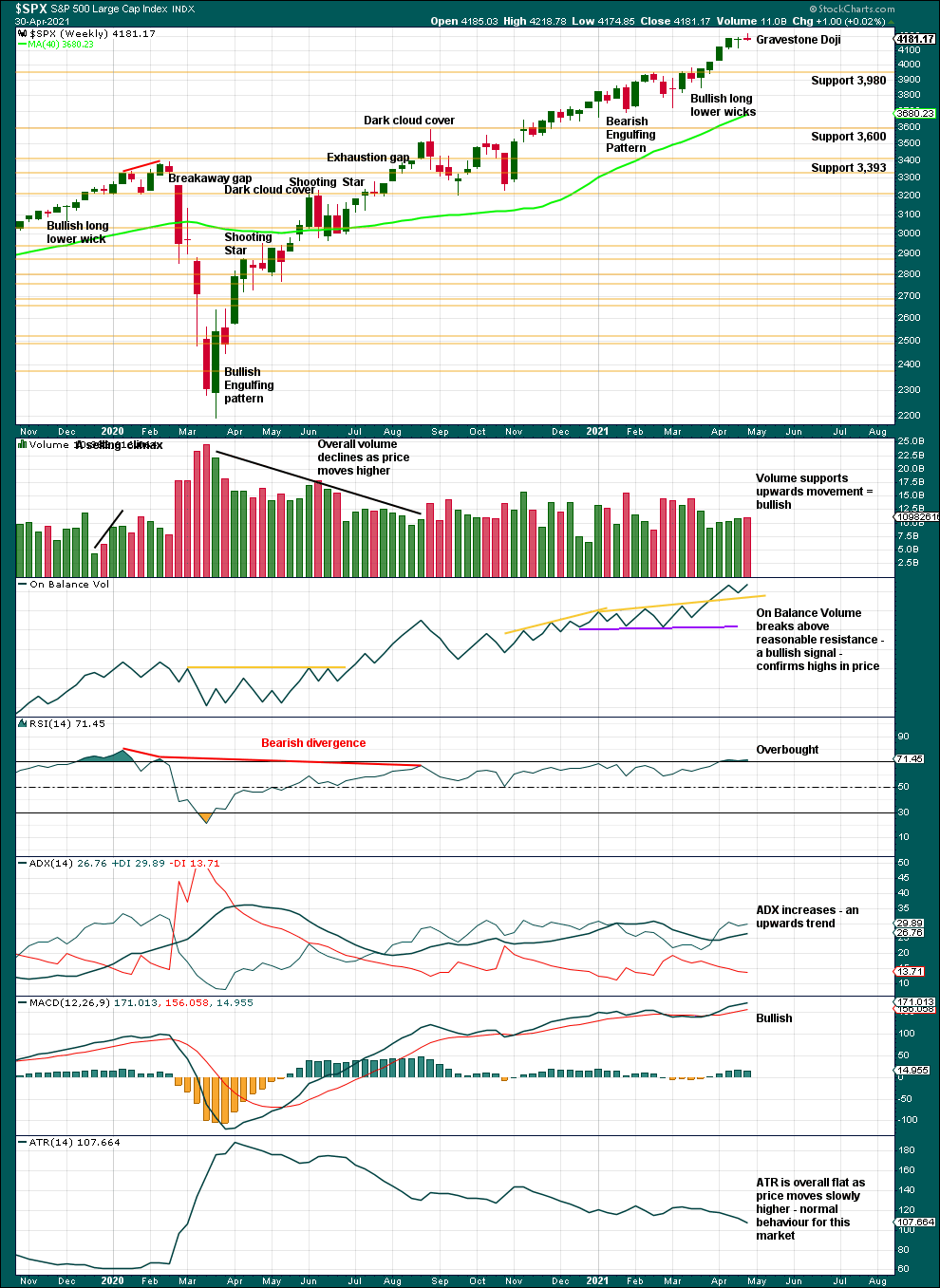
Click chart to enlarge. Chart courtesy of StockCharts.com.
A series of higher highs and higher lows off the low of March 2020 continues. The last short-term swing low is now at 3,723.34. While this remains intact, the dominant view should be of an upwards trend. There is a long way for this trend to run before conditions may become extreme.
This chart has the look of a sustainable bull market in a relatively early stage; there is as yet no evidence that a larger correction should begin here. Although RSI has just now reached overbought, this market has a strong bullish bias and RSI can move deeply overbought and remain there for years prior to the bull market ending.
For the short term, last week closes as a small Gravestone Doji, a bearish candlestick reversal pattern. This supports the second Elliott wave count.
DAILY CHART
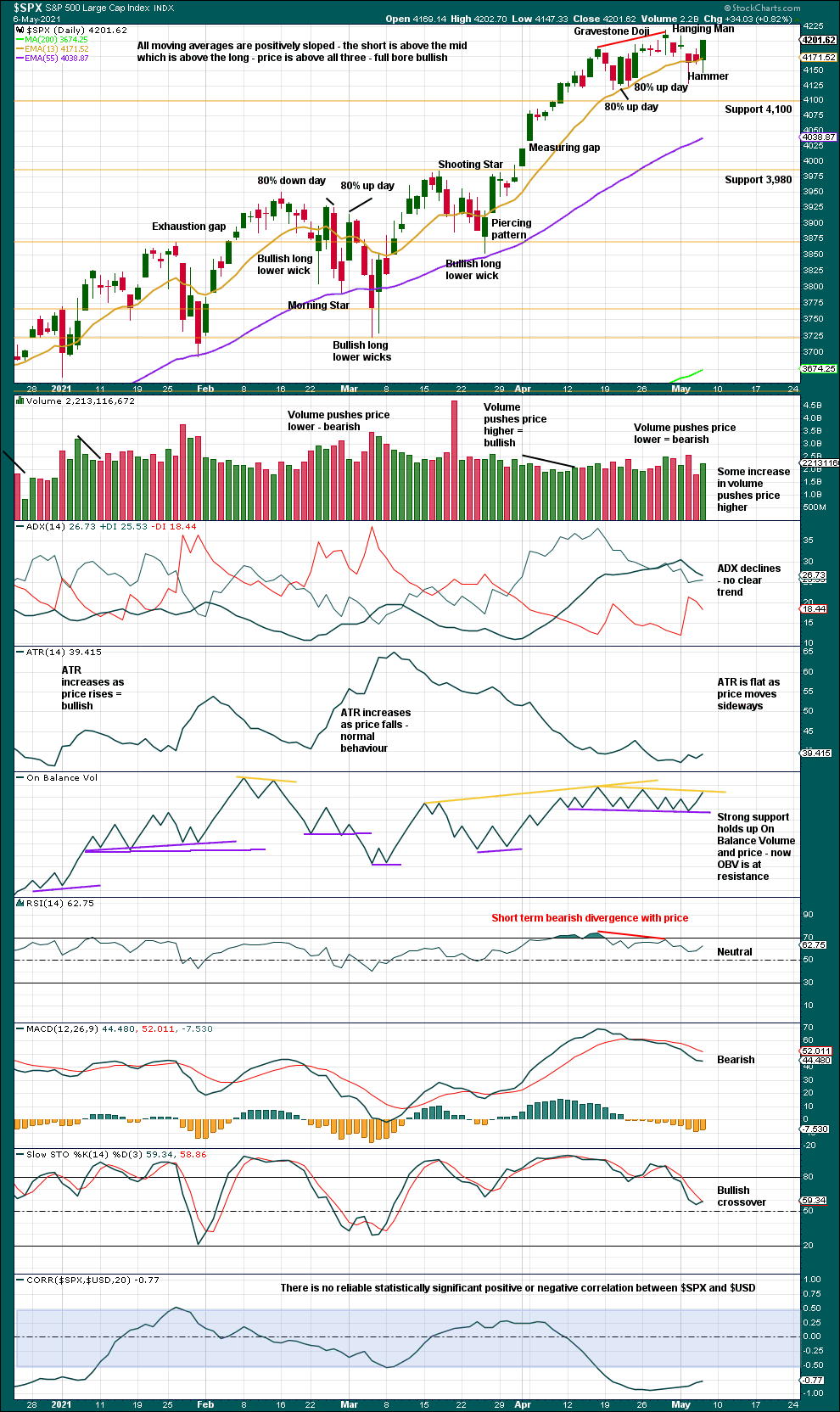
Click chart to enlarge. Chart courtesy of StockCharts.com.
The series of higher highs and higher lows from the low of the 30th of October continues.
Pullbacks are a normal and to be expected part of a bullish trend.
Support for On Balance Volume remains strong. This supports both Elliott wave counts. A new resistance line is added to On Balance Volume; it has weak technical significance as has only two prior anchor points.
A Hammer pattern, a bullish candlestick reversal pattern, supports both Elliott wave counts. Now an upwards session with a little support from volume and a close almost at the high for the session with a slightly bullish long lower wick offers further support to the Elliott wave counts.
BREADTH – AD LINE
WEEKLY CHART
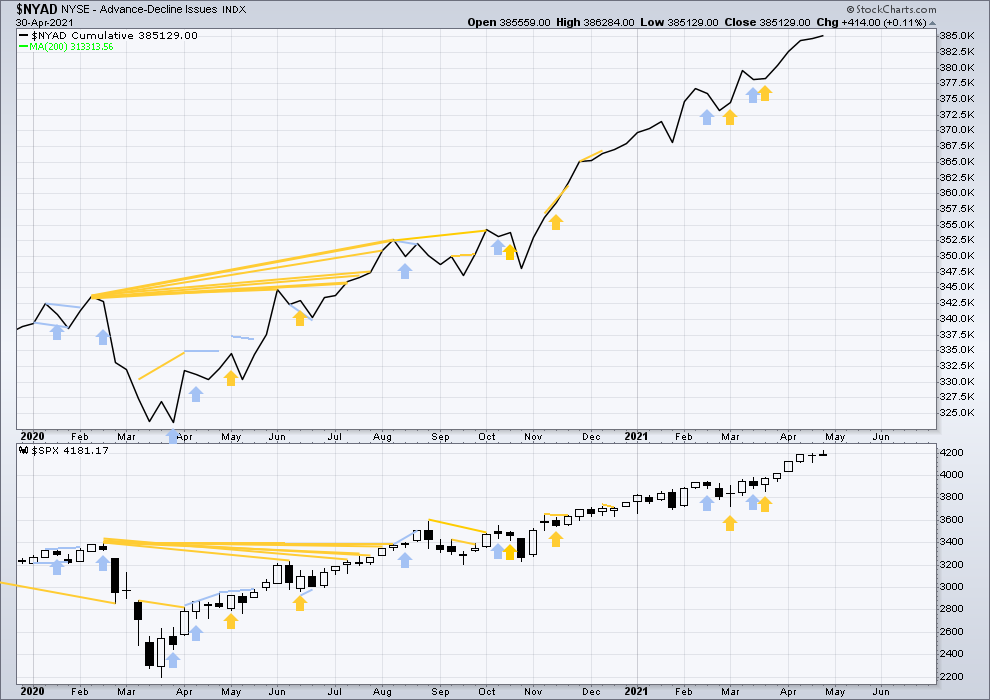
Click chart to enlarge. Chart courtesy of StockCharts.com. So that colour blind members are included, bearish signals will be noted with blue and bullish signals with yellow.
Breadth should be read as a leading indicator.
Lowry’s Operating Companies Only AD line has made a new all time high on the 29th of April. This supports the main Elliott wave count.
Large caps all time high: 4,218.78 on April 29, 2021.
Mid caps all time high: 2,778.84 on April 29, 2021.
Small caps all time high: 1,399.31 on March 12, 2021.
The last new high is found in large and mid caps. Small caps now have a fairly long lag of over a month; this fits with the main Elliott wave count, which expects a minor degree correction may continue. Small caps can lag and large caps can lead for some time while price travels a reasonable distance. Lagging small caps at this stage does not necessarily mean a larger correction should begin here.
Last week again price and the AD line both make new all time highs. Upwards movement has support from rising market breadth. This is bullish and supports both Elliott wave counts.
DAILY CHART
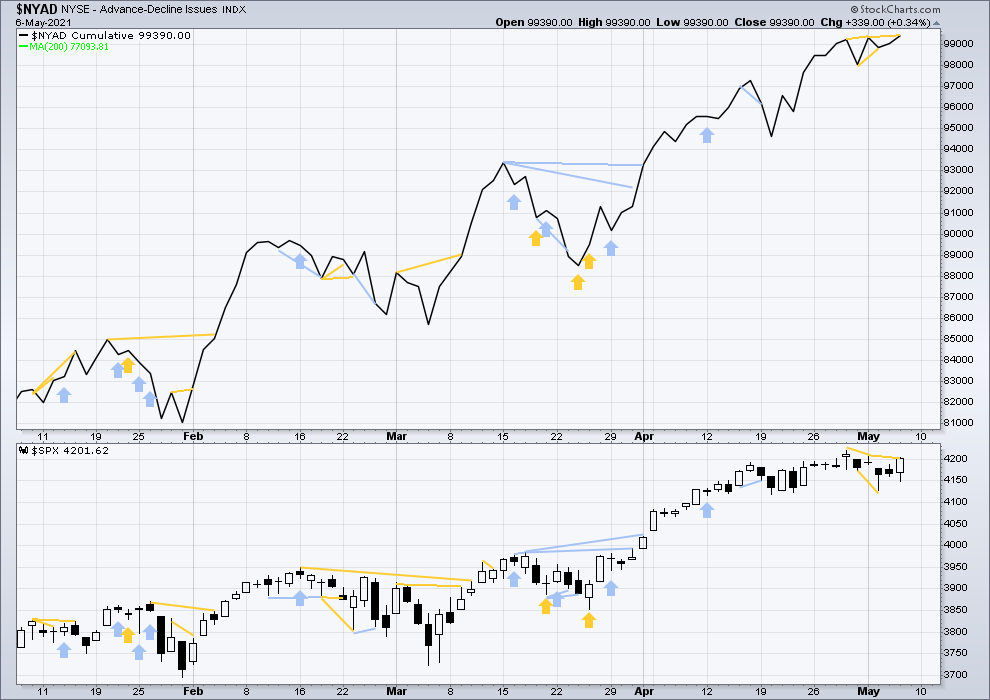
Click chart to enlarge. Chart courtesy of StockCharts.com. So that colour blind members are included, bearish signals will be noted with blue and bullish signals with yellow.
Today both price and the AD line have moved higher. The AD line has made a new all time high by a small margin, but price has not. This divergence is bullish and supports the Elliott wave counts.
VOLATILITY – INVERTED VIX CHART
WEEKLY CHART
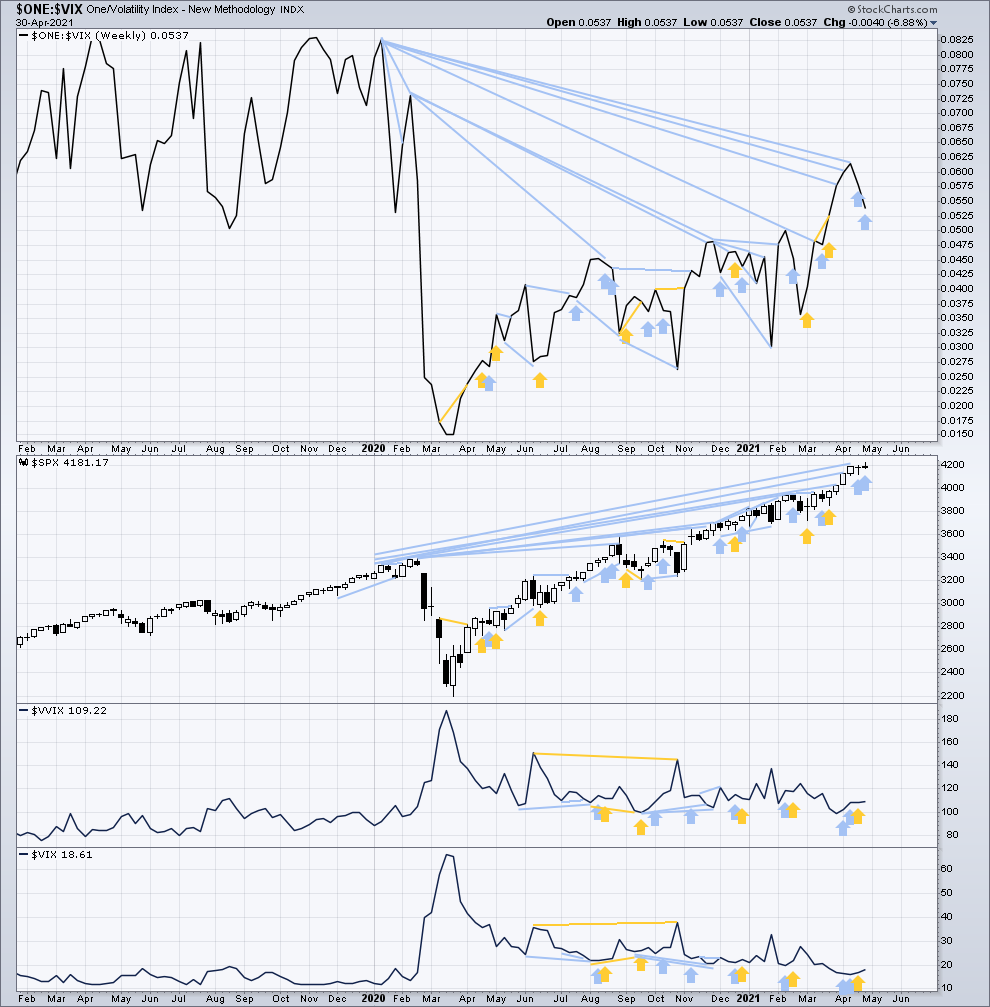
Click chart to enlarge. Chart courtesy of StockCharts.com. So that colour blind members are included, bearish signals will be noted with blue and bullish signals with yellow.
Inverted VIX remains well below all time highs. The all time high for inverted VIX was in the week beginning October 30, 2017. There is over 3 years of bearish divergence between price and inverted VIX. This bearish divergence may develop further before the bull market ends. It may be a very early indicator of an upcoming bear market, but it is not proving to be useful in timing.
For the second week in a row price has moved higher, but inverted VIX has moved lower. This bearish divergence supports the alternate Elliott wave count.
Comparing VIX and VVIX at the weekly chart level:
Last week both VIX and VVIX have moved higher. There is no new divergence.
There is now a cluster of three weeks of short-term bearish divergence for price. This does not support the Elliott wave counts.
DAILY CHART

Click chart to enlarge. Chart courtesy of StockCharts.com. So that colour blind members are included, bearish signals will be noted with blue and bullish signals with yellow.
Both price and inverted VIX have moved higher today. There is no new short-term divergence. Bearish short-term divergence from two sessions ago remains and does not support the Elliott wave counts.
Comparing VIX and VVIX at the daily chart level:
Today both VIX and VVIX have moved lower. There is no new short-term divergence. Bullish divergence from two sessions ago remains and supports the Elliott wave counts.
There is still a cluster of short-term bearish divergence for price.
DOW THEORY
Dow Theory confirms a new bull market with new highs made on a closing basis:
DJIA: 29,568.57 – closed above on 16th November 2020.
DJT: 11,623.58 – closed above on 7th October 2020.
Most recently, on 5th May 2021 both DJIA and DJT have made new all time highs. An ongoing bull market is again confirmed by Dow Theory.
Adding in the S&P and Nasdaq for an extended Dow Theory, confirmation of a bull market would require new highs made on a closing basis:
S&P500: 3,393.52 – closed above on 21st August 2020.
Nasdaq: 9,838.37 – closed above on June 8, 2020.
The following major swing lows would need to be seen on a closing basis for Dow Theory to confirm a change from bull to a bear market:
DJIA: 18,213.65
DJT: 6,481.20
Adding in the S&P and Nasdaq for an extended Dow Theory, confirmation of a new bear market would require new lows on a closing basis:
S&P500: 2,191.86
Nasdaq: 6,631.42
Published @ 08:26 p.m. ET.
—
Careful risk management protects your trading account(s).
Follow my two Golden Rules:
1. Always trade with stops.
2. Risk only 1-5% of equity on any one trade.
—
New updates to this analysis are in bold.

